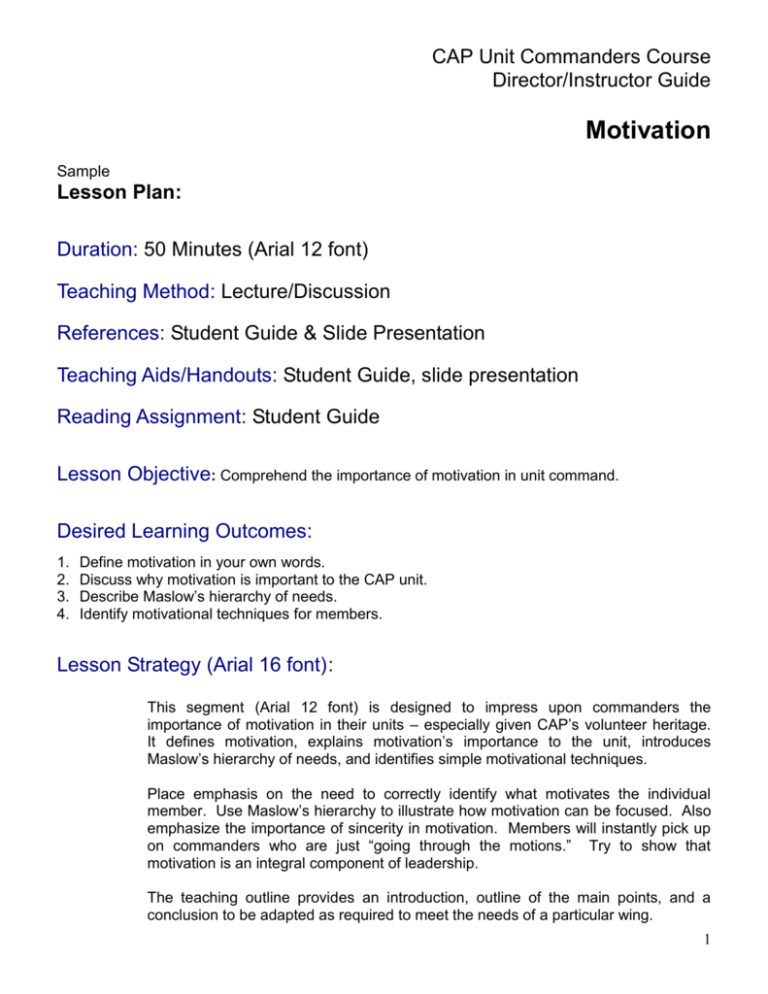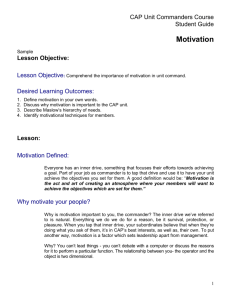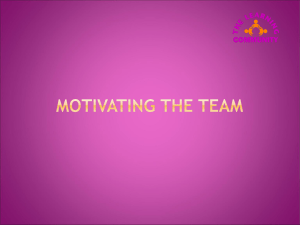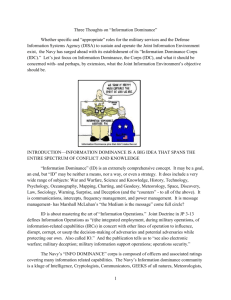CAP Unit Commander Motivation Lesson Plan & Guide
advertisement

CAP Unit Commanders Course Director/Instructor Guide Motivation Sample Lesson Plan: Duration: 50 Minutes (Arial 12 font) Teaching Method: Lecture/Discussion References: Student Guide & Slide Presentation Teaching Aids/Handouts: Student Guide, slide presentation Reading Assignment: Student Guide Lesson Objective: Comprehend the importance of motivation in unit command. Desired Learning Outcomes: 1. 2. 3. 4. Define motivation in your own words. Discuss why motivation is important to the CAP unit. Describe Maslow’s hierarchy of needs. Identify motivational techniques for members. Lesson Strategy (Arial 16 font) : This segment (Arial 12 font) is designed to impress upon commanders the importance of motivation in their units – especially given CAP’s volunteer heritage. It defines motivation, explains motivation’s importance to the unit, introduces Maslow’s hierarchy of needs, and identifies simple motivational techniques. Place emphasis on the need to correctly identify what motivates the individual member. Use Maslow’s hierarchy to illustrate how motivation can be focused. Also emphasize the importance of sincerity in motivation. Members will instantly pick up on commanders who are just “going through the motions.” Try to show that motivation is an integral component of leadership. The teaching outline provides an introduction, outline of the main points, and a conclusion to be adapted as required to meet the needs of a particular wing. 1 CAP Unit Commanders Course Director/Instructor Guide The presenter should personalize the lesson to reflect the unique characteristics of the wing. Lesson Outline: MAIN POINTS: I. II. III. IV. Definition of motivation Why motivation is important Maslow’s hierarchy of needs Motivational techniques for members Teaching Plan (Arial 16 font) Lesson Objective: Comprehend the importance of motivation in unit command. ATTENTION: Have you ever wanted something or to do something so much that you let nothing stand in your way? Have you ever wanted something so much that you sacrificed something else that you wanted in order to get it? MOTIVATION: Motivation is key to mission accomplishment in Civil Air Patrol. When you tap into the inner drive that makes people perform, you make them believe that their doing what you ask not is not only in CAP’s best interest but in their also. It’s a science and an art form, and now we’ll look at motivation from those perspectives. OVERVIEW: In this segment we’ll discuss the definition of motivation and the importance of motivating subordinates in a positive way when accomplishing the mission. We will then discuss Maslow’s hierarchy of needs and why understanding Maslow’s hierarchy is important to you. Finally, we’ll examine some techniques you can use to motivate members at the unit level. TRANSITION: STATE: Everyone has an inner drive. It’s the part of people that focuses their efforts towards achieving a goal. 2 CAP Unit Commanders Course Director/Instructor Guide Main Points: MP I. Definition of motivation (Main Points Bold & Roman Numerals) A. Poll students for their definitions. B. State the book definition. MP II. Why motivation is important A. Why motivation? 1. All people have an inner drive. 2. Everything is done for survival, protection, or pleasure. 3. Motivation sets leadership apart from management. 4. People make choices, and motivation is a key factor. 5. People want to have goals. B. Motivation builds: 1. Trust. 2. Teamwork. 3. United effort. MP III. Maslow’s hierarchy of needs A. Background and theory B. Hierarchy 1. Physiological 2. Safety and Security 3. Social 4. Esteem 5. Self-actualization C. Importance to the commander MP IV. Motivational techniques for members A. Help members meet physiological needs. B. Create and sustain self confidence in membership. C. Provide guidance. D. Recognize the uniqueness in individual members. E. Accentuate the positive. F. Practice participative management. G. Listen. H. Be loyal. I. Have respect for members. J. Recognize member achievements. QUESTION AND ANSWERS: Use the suggested questions to facilitate the discussion, and field any questions that the students may have. 3 CAP Unit Commanders Course Director/Instructor Guide Lesson Summary SUMMARY: Motivating your members is key to mission accomplishment. Members will perform better when they understand the need for their action and feel that somehow their needs are being met in the process. REMOTIVATION: Meeting the art of motivation will help make your people happier and make you a more successful commander. CLOSURE: Getting your people behind you and working toward unit goals is a sure path to success. Take care of their needs and build in them a need to accomplish the mission. Suggested Questions: 1. How would you describe the term “motivation?” Answer: May vary, but look for: “Motivation is the act and art of creating an atmosphere where your members will want to achieve the objectives which are set for them. 2. Why is motivation important to your local squadron? Answer: Motivation is important because it builds trust, teamwork, and a unified effort towards achieving squadron objectives. Members will try harder to do a job when they want to do the job, understand its need for completion, or see an end result which they desire. 3. Can a commander compel members to achieve objectives without motivating them? Answer: Yes, and sometimes it’s necessary because of time constraints or an impending emergency. But in the majority of cases, compelling members is not as effective as positive motivation because it forces a desired course or result and does not address the basic needs of the members. 4. What are the levels of Maslow’s hierarchy of needs, in order of importance? Answer: physiological, safety (security), social needs, esteem needs, and self fulfillment (self actualization). 4 CAP Unit Commanders Course Director/Instructor Guide 5. Which needs must be met before the psychological needs of members may be met? Answer: Physiological 6. What are some of our social needs? Answer: Some social needs are: love, affection and belonging, family, groups, and organizations. 7. Social needs can be broken down into two groups. What are they? Answer: Love and affiliation. 8. What techniques can commanders use to motivate their members? Answers vary, but look for: a. ensure their physiological needs are met b. create and sustain a feeling of self confidence among members c. provide adequate guidance d. recognize the uniqueness in individual members e. accentuate the positive f. practice participative management g. listen h. be loyal to your members i. respect your members j. recognize their achievements in meeting your objectives (say “thank you”) Field any other questions that the students may have. 5







